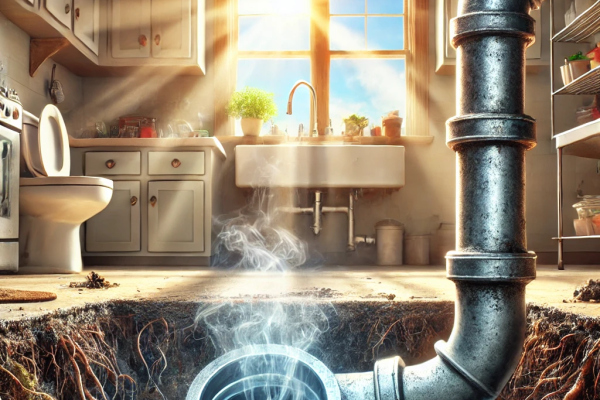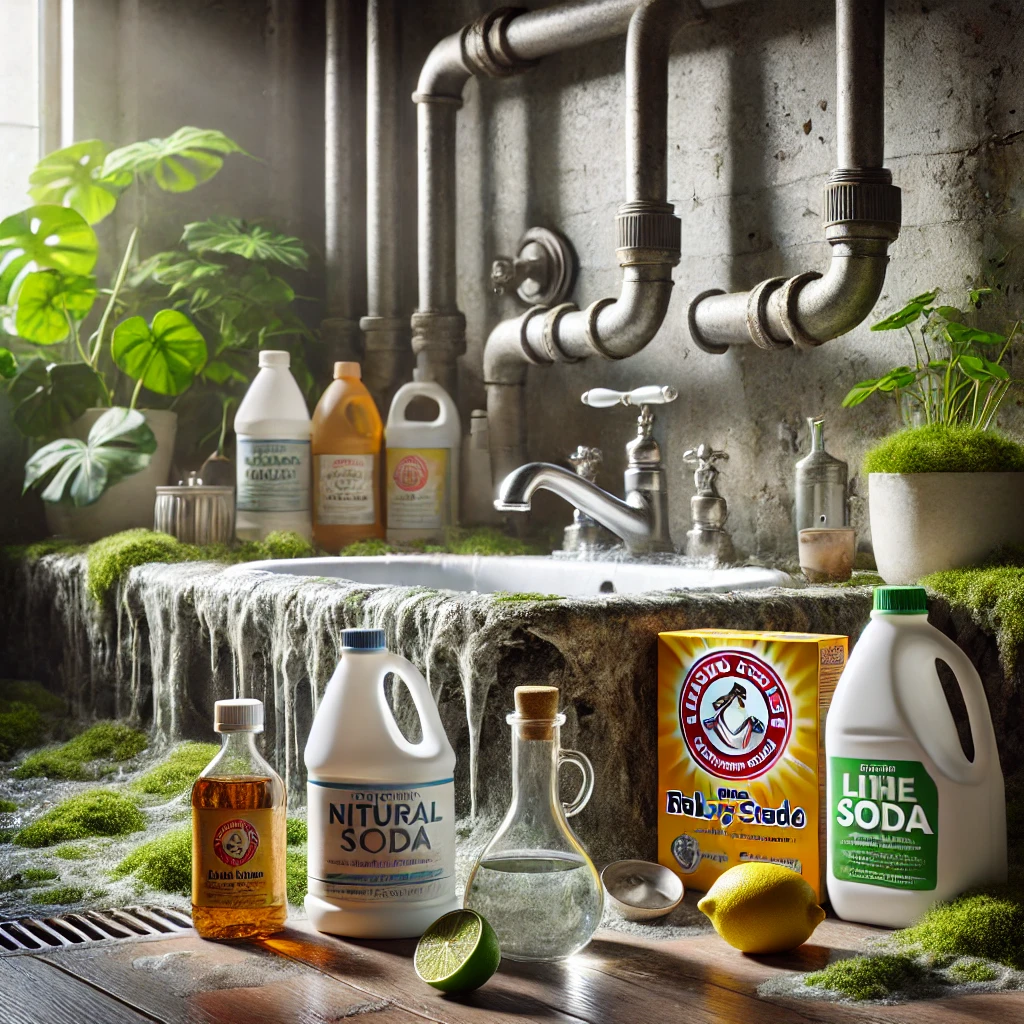
How to Get Rid of Unpleasant Sewer Smells: Tips from a Professional Plumber in Texas
Foul odors rising from your home’s plumbing system into your living spaces can become a real headache for any homeowner. Modern plumbing allows us to effortlessly remove waste and maintain cleanliness, but sometimes, this system fails, and sewer odors creep back through the pipes. In Texas, where high temperatures and dry air can accelerate the evaporation of water in plumbing traps, this issue becomes even more relevant. What should you do if your home starts to smell like sewage, and how can you prevent it from happening again in the future? Let’s explore the solutions step by step.
Why Do Sewer Smells Appear?
To understand the source of these unpleasant odors, we need to review the basic design of a home plumbing system. Water and waste travel through pipes, disappearing into the city or septic sewage system, far from your home. However, when this carefully engineered process is disrupted, sewer gases can rise back into your living spaces through plumbing fixtures.
Normally, plumbing traps (U-shaped pipe bends) protect us from bad odors. These traps hold a small amount of water, creating a barrier that prevents sewer gases from escaping into the home. If the water level in the trap drops too low or dries out entirely, there’s nothing stopping those foul odors from entering your living spaces.
Common Causes of Sewer Smells
Dry Plumbing Trap
In Texas, with its often scorching heat, water in U-shaped traps evaporates much faster. If you rarely use a particular sink or shower, the water in the trap can simply dry out.
Biofilm and Other Build-Up
Drains in kitchens, bathrooms, or laundry rooms may accumulate layers of debris, including food particles, soap residue, hair, and bacteria. These deposits not only create a breeding ground for microbes but also emit unpleasant smells.
Ventilation System Issues
Properly functioning plumbing systems include vent pipes that allow sewer gases to escape outside, typically through the roof. If these vents become clogged, negative pressure can form in the pipes, sucking water out of traps and leaving an open path for sewer odors.
Damaged or Worn-Out Pipes
Cracks or leaks in sewage pipes or connections can allow gases to escape directly into your home.
How to Solve the Problem
1. Refill the Plumbing Trap
The simplest and most obvious step when faced with a sewer smell is to check that your U-shaped plumbing trap contains enough water. Pay special attention to infrequently used plumbing fixtures, such as guest room sinks or outdoor kitchen drains.
Inspect the Trap:
Look under the sink and verify that the pipe forms a “U” or “S” shape.
Add Water:
Run water down the drain for several seconds (or even a few minutes) to refill the trap. For floor drains, slowly pour a bucket of water into the drain.
Check the Result:
Often, the unpleasant smell will dissipate shortly after the trap is refilled. If the odor persists or quickly returns, it’s time to try the next steps.
2. Clean the Pipes
If the issue isn’t a dry trap, the problem might be biofilm build-up inside the pipes. This is particularly common in kitchen sinks, where food debris accumulates, and in bathroom drains, where soap scum and hair can create a similar effect.
Remove the Drain Cover:
Carefully unscrew the drain cover using a screwdriver or the appropriate tool.
Scrub the Pipes:
Use a long, flexible pipe brush to thoroughly clean the interior walls of the pipe, removing any slime or debris.
Disinfect the Drain:
Pour a 50/50 solution of water and bleach into the pipe to kill microbes and neutralize odors. Allow the solution to sit for a while, then flush the drain with clean water.
Be cautious when handling bleach—wear gloves and ensure proper ventilation in the area.
3. Check the Ventilation System
Most home plumbing systems include vent pipes that extend to the roof, allowing sewer gases to escape into the open air. If these vents become blocked by debris like leaves, bird nests, or other obstructions, it can create a vacuum effect that pulls water out of the traps.
Inspect the Roof:
Check the vent openings for visible blockages, such as branches or other debris.
Clear the Vent:
If accessible, remove any blockages. For more severe clogs, professional help may be required. However, in many cases, simply clearing visible obstructions resolves the problem.
4. Examine the Condition of Your Pipes
If none of the previous steps work, the issue might be with the pipes themselves. In older homes in Texas, metal pipes may corrode over time, developing cracks or leaks that allow sewer gases to escape.
Visual Inspection:
Look for signs of moisture, stains, or water damage beneath sinks, in basements, or along exposed pipe sections.
Musty or Moldy Odors:
These can indicate slow leaks, which promote microbial growth and worsen the smell.
Professional Diagnosis:
In cases where visible inspection doesn’t reveal the issue, advanced methods like video pipe inspections can pinpoint the source of the problem.
Preventing Sewer Smells
As with most home maintenance issues, it’s easier to prevent sewer smells than to deal with their consequences. Here are some preventive measures, especially relevant for Texas homeowners:
Use All Drains Regularly
Even if certain plumbing fixtures are rarely used (like a guest bathroom sink), try to run water through them at least once a week to maintain the water barrier in the trap.
Avoid Pouring Grease and Large Food Waste Down Drains
Fats and oils can solidify in the pipes, creating a sticky layer that traps debris and fosters unpleasant smells.
Install Drain Screens
Simple mesh screens can catch hair and food particles, preventing them from accumulating in the pipes.
Use Gentle Cleaning Agents
Enzyme-based cleaners can safely break down organic material without harming your pipes. These are especially useful in preserving older plumbing systems.
Maintain Ventilation Systems
Conduct seasonal inspections of your home, including the roof, to ensure vent openings remain clear and functional.
Special Considerations for Texas Homeowners
Texas’s hot and dry climate can accelerate the evaporation of water in plumbing traps. Additionally, the intense summer heat can speed up bacterial growth inside pipes, worsening odors. Air conditioning, which reduces indoor humidity, can also contribute to faster evaporation in rarely used plumbing fixtures.
Seasonal weather events, like hurricanes or sudden heavy rains, can affect plumbing systems by altering atmospheric pressure. These changes may temporarily disrupt vent functionality, causing sewer gases to enter the home.
Given these unique challenges, Texas homeowners should be especially vigilant about plumbing maintenance and proactive in preventing issues.
When to Call a Professional
While many sewer smell problems can be resolved with DIY methods, there are situations where professional help is necessary. Persistent odors, visible damage to pipes, or severe blockages may require the expertise of a licensed plumber. In Texas, where specific regional conditions can influence plumbing systems, an experienced professional can provide tailored solutions for your home.
It’s important to remember that unpleasant smells are often the first warning sign of deeper plumbing issues. Addressing them early can save you from costly repairs and health risks later on.
Conclusion
Sewer odors in the home are not just a nuisance—they can indicate underlying issues that need attention. In Texas, where the climate presents unique challenges to plumbing systems, it’s crucial to stay on top of regular maintenance and take proactive measures to prevent problems.
By understanding how plumbing systems work, regularly using all drains, cleaning pipes, and ensuring proper ventilation, you can keep your home odor-free and comfortable. If problems persist despite your best efforts, don’t hesitate to seek professional advice to diagnose and fix the issue.
A little preventative care can go a long way in ensuring the safety, freshness, and comfort of your home, whether it’s nestled along a peaceful Texas lake, surrounded by the state’s rolling plains, or located in the bustling heart of a major city.






